Before Starting a Yoga Set or Meditation
Press the thumbs on the chest at the sternum. Inhale deeply and focus your concentration at the third eye and then chant the mantra:
“Ad Guray Nameh, Jugad Guray Nameh, Sat Guray Nameh, Siri Guru Devay Nameh”.
This mantra links you with the eternal space of the “Shabad Guru”. The Shabad Guru is the guiding principle in Kundalini Yoga, it is not personal, it’s an eternal vibratory frequency. It’s Sat, true, it never changes.
Ad Guray: Guru which existed before creation
Nameh:I bow
Jugad Guray: Guru which is throughout all time
Sat Guray: Guru which is True
Siri: Great
Guru: that which transforms darkness to light
Devay: angelic, unseen
During the Yoga Kriya
A kriya is a specific series of asanas, or body postures, combined with pranayama, mantra and mental focus to create a specific effect. Training the mind and the body to be in synchronicity with the breath is a critical aspect of Kundalini Yoga. While doing the asanas: when inhaling, mentally vibrate the sound “Sat”, and when exhaling, mentally vibrate the sound “Nam.” “Sat” means “truth” and “Nam” means “identity of truth,” or to identify with truth. This mantra will be used when harmonizing the body, mind and breath unless otherwise specified in the set or meditation. When your mind drifts off, be patient with yourself. Simply remember to focus while drifting occurs by gently bringing your awareness back to the mantra. Always intend to be focused and be forgiving when it fades.
What follows are abbreviations and other frequently used words in the descriptions of the yoga sets and meditations that follow.
Locks (Bandhas)
MB: Mulbandh is the root lock. It is a process of contracting all 3 of the following muscle groups at the same time:
• The rectal muscles
• The muscles that control the sexual organs and urination
• The navel point (pull it towards your spine)
This is done in conjunction with:
• Holding your chin in
• Lifting your heart up
• Rolling your eyes up internally and looking at the screen of your forehead
• Concentrating at your third eye
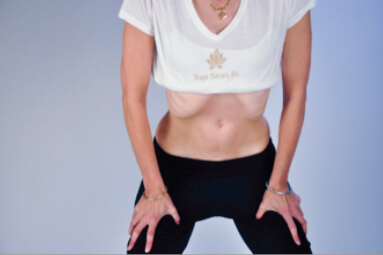
Diaphragm Lock (Uddiyana Bandh) To master this bhanda, we recommend that you include it in your daily practice. Do this with absolutely no food or liquid in your stomach. Practice it first thing in the morning after your cold shower while standing in front of a mirror. Place your hands above your knees at the tops of your thighs while bending forward slightly (30º). Exhale your breath out and do not allow any breath to come back into the lungs while applying the bhanda. With your breath held out, pull your abdominal muscles in and up. Make sure that the muscles of your diaphragm pull up and in, and then also pull up under the rib cage. The key to this is to apply pressure downward with your hands where you have placed them above your knees. Repeat holding and releasing the lock several times with your breath held out.
Neck Lock (Jalandhar Bandh) This bandha is applied during meditation, while chanting and during pranayama (the art of working with the energy of the subtle breath). It facilitates the kundalini energy to rise into the higher centers. Lift your heart as you stretch the back of your neck, keeping your head level and centered. You should feel a slight pressure at your throat.
Maha Bandh is a special lock in Kundalini Yoga that is applied in order to move the kundalini energy up through the sushmana channel, which creates a state of fearlessness. On an exhale, apply all three aforementioned bandhas: MB, neck lock and the diaphragm lock, and focus at your brow point.
These bandhas protect as they align the physical and energetic structures to allow the kundalini to rise up the central sushmana channel.
We recommend the following practice at the end of each asana to consolidate the projection-connection-reception of your radiant body:
At the end of an asana, inhale and hold your breath as you:
* Focus at your third eye, between your eyebrows at the bridge of your nose
* Pull your chin in slightly
* Lift your heart center up
* Contract MB
Seals (Mudras)
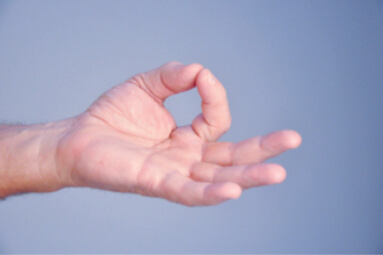
Gyan Mudra: (GM). The tip of your thumb touches the tip of your index finger. This mudra gives mastery over the energy of Jupiter, the expression of expansion and knowledge. When you need more knowledge or you need expansion in your consciousness to deal with some event, then choose GM. Mastery of the mudra will give you control over the positive aspects of the planet Jupiter and it will eliminate the negative patterns that you may have picked up in this life or a past life. Incorporating this mudra into your daily practice is an effective way to deal with the planetary influence of Jupiter for the benefit of your higher self.
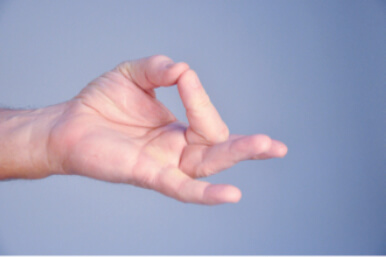
Shuni Mudra can give a person mastery over the energy of the planet Saturn. Touch the tip of your thumb to the tip of your second finger next to your index finger (middle finger). This mudra seals in the energy of Saturn and gives both wisdom and patience. Life may be showing you your impatience and/or a lack of wisdom in your decision making process. Always imagine Saturn’s positive aspects of patience and wisdom before embarking on this journey of transforming old karmic tendencies. This alchemical process is the journey of our lifetime, our destiny work, our dharma.
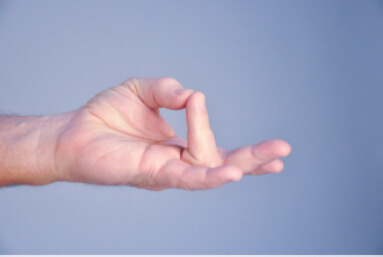
Surya Mudra is made by holding the tip of your thumb to the tip of your ring finger. This mudra seals in the energy of the Sun, and brings about physical vitality. If you are weak and do not have the energy to show up for your life, mastering this mudra can connect you essentially with all the energy you want in order to physically handle the challenges and requirements of living your life.
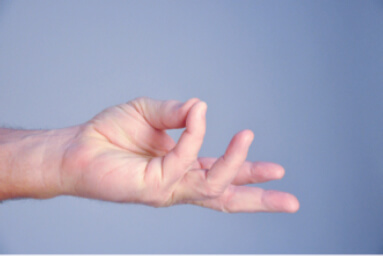
Buddhi Mudra is formed by touching the tip of your thumb to the tip of your smallest finger, commonly called the pinky finger. This mudra relates to the planet Mercury and rules the aspect of communication. Mastery of this mudra reveals a conscious relationship to communication. Communication is about effective speaking, as well as the ability to listen. If this is an area of concern, then the practitioner who does this mudra with devotion will realize powerful awareness shifts in all aspects of conscious communication.

Venus Locok: (VL) Venus Lock masters the balance between the energies of Venus and Mars. Venus expresses the feminine energy of love and harmony and Mars expresses the masculine energies of passionate impulse and action. If you find there is too much or too little love or passion in your relationships, then conscious application of VL can transform these karmic patterns. It will create a balance between the two complimentary energies needed to achieve fulfillment. Mastery transforms negative influence and allows the positive to be summoned forth as a new, permanent habit. To increase your feminine energy, interlace your fingers with your right little finger on the bottom. Put your right thumb above the base of your left thumb on the webbing between your thumb and index finger. Press the tip of your left thumb on the fleshy mound at the base of your right thumb. Reverse this mudra to increase your masculine energy.
Pranayam (Subtle Breath)
BOF: Breath of Fire is a balancing breath generated by a rapid, continuous movement of the abdominal muscles. Practiced through your nostrils, exhale as you press the navel point back toward the spine. The inhale will come in as part of relaxation of your abdomen, rather than through effort. Sit comfortably with a straight spine. Rest your hands on your knees, palms up, with your fingers in GM, touching the tips of the index finger to the tips of the thumbs. Breathe fairly rapidly—about two or three breaths per second—through your nose while you pump your navel point and abdomen. Pull your abdomen inward on the exhale and relax it out during the inhale. Your chest should be relaxed. When you are finished, inhale deeply and hold the breath while you pull the energy up into your higher centers. Then exhale and relax. This is a balanced breath with no emphasis on either the inhale or the exhale. Think of it as one continuous breath being pulled in and out. You will not hyperventilate if you do not breathe through your mouth. Start practicing breath of fire for no more than 3 minutes at a time and work up to 31 minutes or more.
Once mastered, BOF can be done for a very long period of time. Yogis know that at birth each person is granted a certain amount of breaths. Continuous breath of fire is considered to be one breath, even if you do it for 31 minutes.
LDB: Long deep breathing. Sit in easy pose; inhale through your nose and bring as much air into your lower lungs as possible. The signature of a long deep breath is that you see your abdomen go out first as you pull the air in, then the air moves up and fills the middle of the lungs, and finally the air fills the upper part of the lungs (clavicular area). Continue LDB in three equal parts: inhaling the air first into your lower, then to your middle, and then your upper lungs. As you exhale, release all of the air first out of the upper part of your lungs, then the middle and finally the lower, by pushing your abdomen towards your spine. To create a complete mudra (seal) for the flow of energy, always focus your eyes at the tip of your nose or at your third eye. As yogis we strive to create a habit of this natural breath and train the lungs as frequently as possible throughout the day by consciously breathing long and deep.
Mantras
In Kundalini Yoga we use the “yoga of sound” often during the kriyas and meditations. Sacred sound is referred to as the Shabad Guru and this is the Guru in the Kundalini Yoga lineage. There is no personality established as Guru, only the permutation and combination of specific sacred sounds. The mantras stimulate the higher glands and move the yogi’s awareness from (“Gu”) darkness into (“Ru”) light. Mantras can be repeated 108 times per day to experience the vibratory essence of the experience of “Truth,” beyond time and space, beyond right and wrong, that which always was, is and will be.
When no other instruction is given during an asana, mentally vibrate the mantra “Sat” on the inhale, and “Nam” on the exhale. “Sat Nam” holds the mind present and attunes your personal energy to a universal frequency.
Eye Focus (Drishti)
An eye focus is part of creating a mudra or energy seal during any asana or meditation as it channels the mind and causes glandular secretions when the eye muscles massage the higher glands.
Third eye point: The point between the eyebrows at the bridge of the nose. This is the default focus for any asana or meditation if no other instruction has been given. It activates the pituitary gland and balances the nervous system.
Tip of the nose: Eyes are 9/10th closed and the focus is at the tip of the nose. This focus stimulates the pituitary gland and the frontal lobe of the brain. It is very difficult for most yogis to hold this dhristi. Make it your priority to practice this important yogic skill. Look at the nose with your left eye closed and see if you can see the tip of the nose with your right eye. Then close the right eye and see if you can see the tip of the nose with the left eye. Keep practicing until you are sure you can see the tip of the nose equally with both eyes when applying this dhristi.
Chin point: Eyes are closed and internally look down at the chin, the lunar center.
Crown chakra: Located at the top of the skull. Eyes are closed and internally looking out the top of the head, stimulating the pineal gland.
Common Asanas

Stretch Pose: Lie on your back on a firm, cushioned surface. Stretch your legs forward with feet together and toes pointed, and extend your arms parallel to your hips, but not touching them, with your fingertips pointing toward your toes, palms down. Raise your arms, feet and head 6 inches off the floor and focus your eyes on your toes. Hold this position for 1 to 3 minutes or longer, using LDB or BOF.
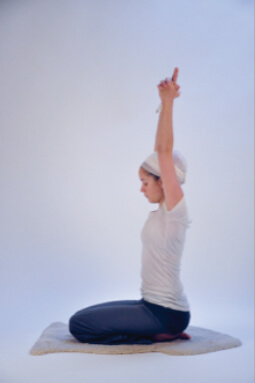
Sat Kriya: A fundamental kriya to Kundalini Yoga, it directly stimulates and channels the kundalini energy. Sit on your heels and lift your arms up with your palms together. Interlace all your fingers except your index fingers, which point up. To increase your masculine energy, place right thumb over the left thumb and to increase your feminine energy cross the left thumb over the right. As you pull in your navel, chant “Sat” powerfully and chant “Nam” as you relax your navel. To end, inhale and apply MB, then exhale and hold your breath out as you apply Maha Bandh (all locks) and visualize the energy moving out of the tenth gate (top of your head) into the Cosmos. Inhale and relax with your forehead on the ground.
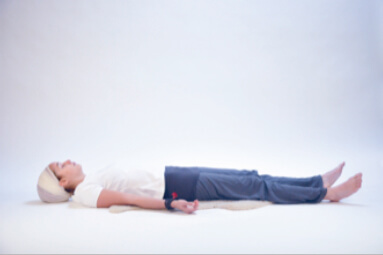
Corpse Pose: Lie on your back with your legs slightly apart, arms by your sides with palms facing up. Yoga masters often refer to this asana as a difficult pose, since it requires complete release, stillness and surrender. This is where the affects of the kriya are absorbed into the physical body and where the subtle bodies harmonize.
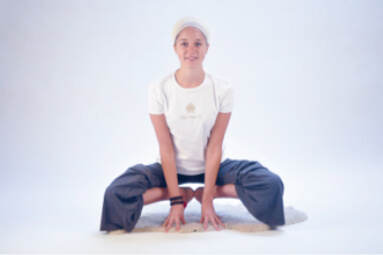
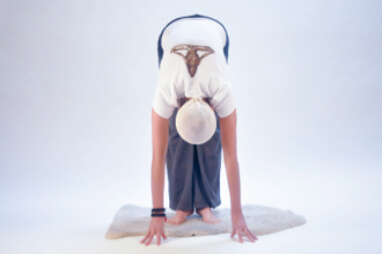
Frog Pose: Squat down, keeping your heels off the ground, and place your fingers on the ground in front of your toes. Your arms are in between your knees. Inhale, straighten your legs and keep your head down. Exhale, squatting down with your heels off the ground and lift your head so it is in line with your spine.
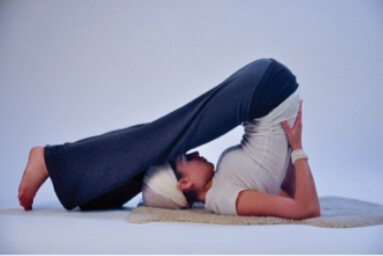
Plow Pose: Lying on your back, raise your legs up to 90º (Shoulder Stand), then continue to lift them past your shoulders until your toes touch the ground over your head. Your arms can be raised above your head with your hands holding your feet, or your arms can stay at your sides.
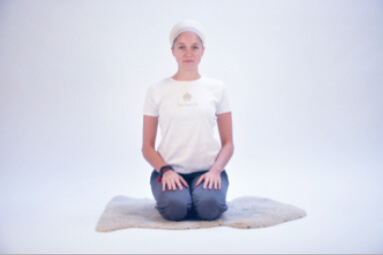
Rock Pose: Sit on your heels, mindful to keep your feet next to each other and not crossed. Your hands rest flat on your thighs with your palms face down.
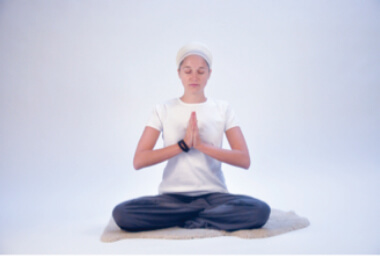
Easy Pose: Sit with your legs crossed. If your knees do not come down enough to allow for a comfortable seat, then sit on a meditation pillow. This will help to bring your low back in correct alignment, which allows your hips to release and your knees to lower. This posture is often difficult for adult Westerners, as many have unlearned sitting on the floor, which keeps the hips flexible. Sitting in chairs causes the hamstrings to shorten and leads to a loss of flexibility in the hips. This self-corrects slowly as you sit on the floor and practice, practice, practice!
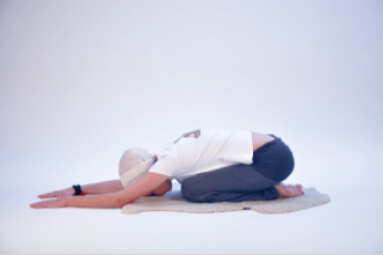
Gurpranam/Baby Pose: Sit on your heels and place your forehead on the ground in front of your knees. Your arms are by your sides, palms facing up, or your arms are straight out in front of you, palms facing down.

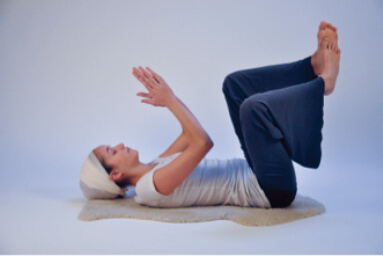
Inhale and hold your breath briefly to consolidate the energy, then as you exhale, lie on your back in corpse pose. Your arms are by your sides with your palms face-up and your legs spread 12 inches apart. You can cover yourself with a blanket and listen to a gong or other harmonic/healing sound as you deeply relax for 10 minutes.
To come out of the relaxation, deeply inhale and exhale several times, then begin to move your wrists and ankles in small circles. Rub your palms together and the soles of your feet together briskly.
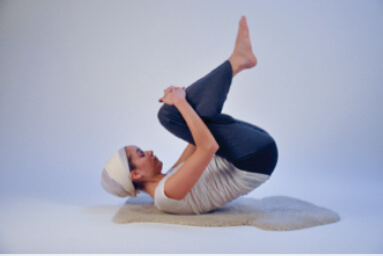

Pull your knees to your heart center, wrap your arms around your knees and rock forward and backward on your spine several times as you inhale up and exhale down.
Sit up into easy pose with your hands in prayer pose and sing, “May the long time sun shine upon you; all love surround you. And the pure light within you, guide your way on.” There are several versions of this song available. Close the kriya by chanting one long “Sat Nam.”
This completes our practice, our sacred ceremony.